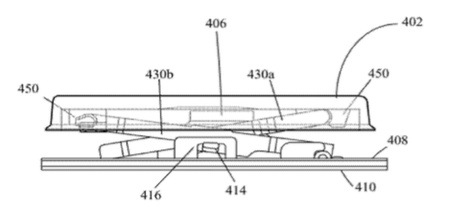An Apple patent (number 20120199455) for a keyboard design has appeared at the U.S. Patent & Trademark Office. It’s for a backlit keyboard with controlled halo brightness and contrast.
Per the patent, a keycap assembly is mounted into a case web having intersecting ribs. A flange, which can be angled, is on the bottom perimeter of the keycap and a correspondingly shaped flange is on each rib of the case web. An overlap of the keycap flange and the case web flanges prevents direct sighting of the backlight light source and also provides a more evenly distributed halo around the keycap, thereby improving both aesthetics and functionality by providing better light control and contrast.
Here’s Apple’s summary of the invention: “In one embodiment, a backlit keyboard assembly includes a keycap assembly mounted in a case web at an aperture formed by intersecting ribs of the case web. The keycap assembly has a flange around a perimeter of the bottom of the keycap and an internal stopping mechanism for stopping the keycap at a designed height. Each rib has a case web flange having a geometry corresponding to that of the keycap flange, and the keycap flange and the case web flange do not contact each other. When the internal stopping mechanism stops the keycap at the designed height, an overlap between the keycap flange and case web flange prevents direct visibility of a backlight light source by a user allowing a legend and halo brightness and contrast to be controlled more precisely.
“In another embodiment, a keyboard is described. The keyboard includes a keycap and a case web in which the keycap is mounted. The case web includes intersecting ribs that have case web flanges. The keycap assembly includes at least a keycap having a keycap flange attached to a bottom perimeter of the keycap, a scissor-type mechanism for supporting the keycap, a rubber dome underneath the keycap for providing tactile feel to a user, a layered membrane with switch circuit, a base plate for support of the keycap assembly, and a backlight light source underneath the base plate. The keycap flange and case web flanges overlap but do not contact each other such that the backlight light source cannot be directly seen by the user. A vertical stop pin can also be attached to a pivot of the scissor mechanism, and a stopping mechanism can also be provided for restricting vertical motion of the vertical stop pin at a predetermined distance from the base plate.
“According to still another embodiment, a method of making a keyboard is described. A base plate having a backlight light source underneath the base plate can be provided. The base plate is then engaged with a scissor type mechanism, which is engaged with a keycap having a keycap flange around a perimeter of a base of the keycap. A case web is positioned over the keycap such that a case web flange corresponds to the keycap flange without contacting the keycap flange, wherein an overlap of the case web flange and the keycap flange prevent a user from directly seeing the backlight light source.”
The inventors James N. Niu, Harold J. Welch, Chad A. Bronstein, Patrick Kessler and Chris Ligtenberg.


